
A mural is any piece of graphic artwork that is painted or applied directly to a wall, ceiling or other permanent substrate. Mural techniques include fresco, mosaic, graffiti and marouflage.

Maria Anna Angelika Kauffmann, usually known in English as Angelica Kauffman, was a Swiss Neoclassical painter who had a successful career in London and Rome. Remembered primarily as a history painter, Kauffman was a skilled portraitist, landscape and decoration painter. She was, along with Mary Moser, one of two female painters among the founding members of the Royal Academy in London in 1768.

Giovanni Battista Tiepolo, also known as GiambattistaTiepolo, was an Italian painter and printmaker from the Republic of Venice who painted in the Rococo style, considered an important member of the 18th-century Venetian school. He was prolific, and worked not only in Italy, but also in Germany and Spain.
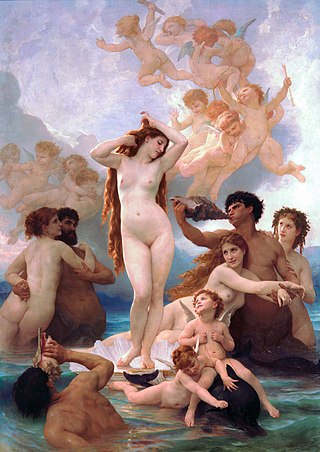
Academic art, academicism, or academism, is a style of painting and sculpture produced under the influence of European academies of art. This method extended its influence throughout the Western world over several centuries, from its origins in Italy in the mid-16th century, until its dissipation in the early 20th century. It reached its apogee in the 19th century, after the end of the Napoleonic Wars in 1815. In this period, the standards of the French Académie des Beaux-Arts were very influential, combining elements of Neoclassicism and Romanticism, with Jean-Auguste-Dominique Ingres a key figure in the formation of the style in painting. The success of the French model led to the founding of countless other art academies in several countries. Later painters who tried to continue the synthesis included William-Adolphe Bouguereau, Thomas Couture, and Hans Makart among many others. In sculpture, academic art is characterized by a tendency towards monumentality, as in the works of Auguste Bartholdi and Daniel Chester French.
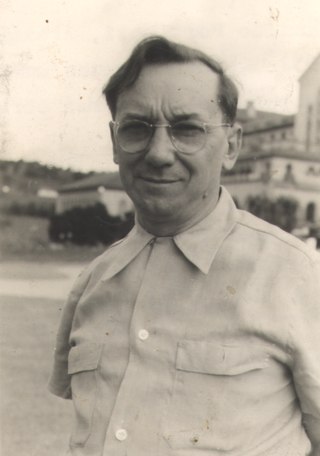
Candido Portinari was a Brazilian painter. He is considered one of the most important Brazilian painters as well as a prominent and influential practitioner of the neo-realism style in painting.

Albert Pinkham Ryder was an American painter best known for his poetic and moody allegorical works and seascapes, as well as his eccentric personality. While his art shared an emphasis on subtle variations of color with tonalist works of the time, it was unique for accentuating form in a way that some art historians regard as a precursor to modernism.
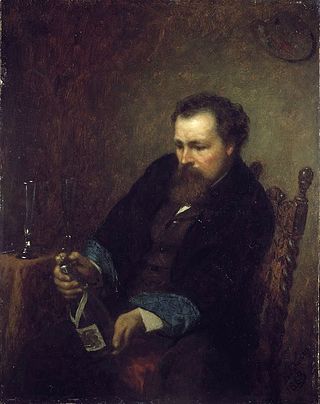
Jonathan Eastman Johnson was an American painter and co-founder of the Metropolitan Museum of Art, New York City, with his name inscribed at its entrance. He was best known for his genre paintings, paintings of scenes from everyday life, and his portraits both of everyday people and prominent Americans such as Abraham Lincoln, Nathaniel Hawthorne, Ralph Waldo Emerson, and Henry Wadsworth Longfellow. His later works often show the influence of the 17th-century Dutch masters, whom he studied in The Hague in the 1850s; he was known as The American Rembrandt in his day.
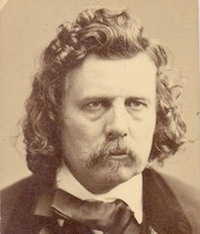
William Holbrook Beard was an American artistic painter who is known best for his satirical paintings of beasts performing human-like activities.

Child art is considered drawings, paintings, or other artistic works created by children. It has been used as a therapeutic tool by psychologists and as an ethnographic tool to further understand children of the past. Within developmental theory, the art of each child reflects their level of self-awareness and the degree to which they are integrated with their environment.

Visual arts education is the area of learning that is based upon the kind of art that one can see, visual arts—drawing, painting, sculpture, printmaking, and design in jewelry, pottery, weaving, fabrics, etc. and design applied to more practical fields such as commercial graphics and home furnishings. Contemporary topics include photography, video, film, design, and computer art. Art education may focus on students creating art, on learning to criticize or appreciate art, or some combination of the two.
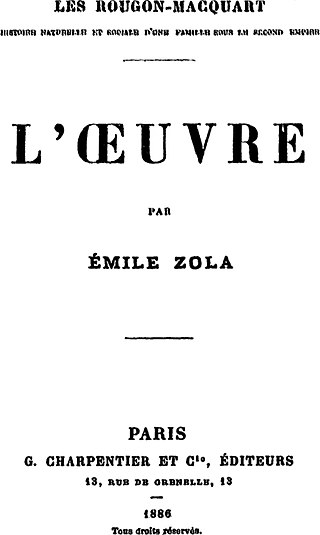
'L'Œuvre(The Masterpiece)' is the fourteenth novel in the Rougon-Macquart series by Émile Zola. It was first serialized in the periodical Gil Blas beginning in December 1885 before being published in novel form by Charpentier in 1886.
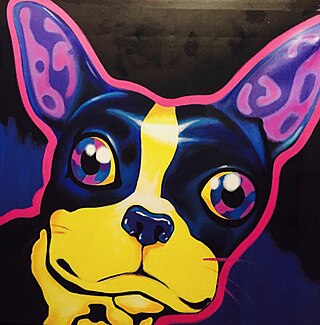
William "Bill" Kincaid was known as a costume designer until 1990, and is also known as an artist creating pet paintings in brilliant colors on large canvases.
The compadre relationship between the parents and godparents of a child is an important bond that originates when a child is baptised in Iberian, Latin American, Filipino Christian and Indian Goan Christian Brahmin families. The abstract nouns compadrazgo and compadrio (Portuguese), both meaning "co-parenthood," are sometimes used to refer to the institutional relationship between compadres.

Affandi was an Indonesian artist. Born in Cirebon, West Java, as the son of R. Koesoema, who was a surveyor at a local sugar factory, Affandi finished his upper secondary school in Jakarta. He gave up his studies to pursue his desire to become an artist. Beginning in 1934, Affandi began teaching himself how to paint. He married Maryati, a fellow artist. One of his children, Kartika also became an artist.

Helen Galloway McNicoll was a Canadian impressionist painter. She was one of the most notable women artists in Canada in the early twentieth century and achieved considerable success during her decade-long career. McNicoll played an important role in popularizing Impressionism in Canada, at a time when it was still relatively unknown, with her lively representations of rural landscapes, intimate child subjects and modern female figures. She was elected to the Royal Society of British Artists in 1913 and was created an Associate of the Royal Canadian Academy of Arts in 1914.

Anna Maria Elisabeth Lisinska Jerichau-Baumann was a Polish-Danish painter. She was married to the sculptor Jens Adolf Jerichau.
Wadsworth Aikens Jarrell is an American painter, sculptor and printmaker. He was born in Albany, Georgia, and moved to Chicago, Illinois, where he attended the Art Institute of Chicago. After graduation, he became heavily involved in the local art scene and through his early work he explored the working life of African-Americans in Chicago and found influence in the sights and sounds of jazz music. In the late 1960s he opened WJ Studio and Gallery, where he, along with his wife, Jae, hosted regional artists and musicians.

Chidi Kwubiri is a Nigerian-German visual artist.
Mykola Malynka was a Ukrainian painter, creative artist, and sculptor. He was among those who studied and worked in the Soviet Union where Socialist Realism became a state policy, but is often considered a representative of Ukrainian impressionism as well. Focused on the dramatic depictions of Soviet and Ukrainian history, Mykola Malynka produced canvases of Ukrainian Cossack's quest for peace and freedom, portrayed prominent personalities of the past and present day, composed a brief history of his homeland - Yahotyn county of Kyiv Region. Later, when Gorbachev's glasnost’ effectively ended state censorship, he began to reveal on the canvas Ukrainian national tragedies, such as the forcible collectivization and the Great Famine (Holodomor) of 1933, which took millions of Ukrainian lives.

The Graham Children is an oil painting completed by William Hogarth in 1742. It is a group portrait depicting the four children of Daniel Graham, apothecary to King George II. The youngest child had died by the time the painting was completed.
















